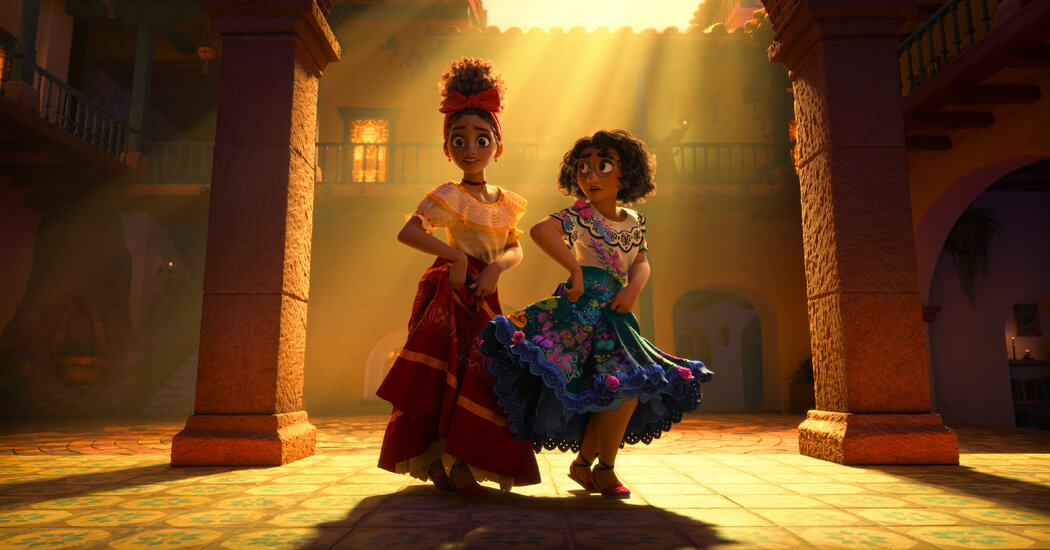“We Don’t Talk About Bruno” from “Encanto” is a surprise chart topper and TikTok darling. Here’s how Disney created its biggest smash since “Let It Go.”
“A seven-foot frame! Rats along his back!” a curly-haired teenager draped in a cloak lip-syncs for the camera.
“I associate him with the sound of falling sand,” a busy mom nods appreciatively, bopping along with a vacuum as she embarks on a kitchen dance break.
“I’m sorry, mi vida, go on!” a pair of sisters screech, perilously off-key.
“Encanto” cautioned against talking about Bruno, but a whole lot of people are obsessed with a song about him.
Since that animated Disney film opened in theaters in November and arrived on Disney+ on Christmas Eve, its playful song “We Don’t Talk About Bruno” has steadily grown into an international hit. Unlike most Disney breakouts, “Bruno” is not a wistful hero’s solo or a third-act power ballad. It’s a Broadway-style ensemble track that revels in gossip about a middle-age man.
Yet the song recently topped the Spotify, Apple Music and iTunes charts in the United States, reached No. 1 on the global YouTube music videos chart and currently sits at No. 5 on the Billboard Hot 100 — the first original song from a Disney animated film to rank that high since the “Frozen” anthem “Let It Go” in 2014. Other “Encanto” tracks, like “Surface Pressure” and “The Family Madrigal,” are also rising. And this week, the film’s soundtrack bumped Adele’s “30” from the top spot on the Billboard 200.
“Bruno” has been bolstered by its popularity on TikTok, where tribute clips from the likes of that cloaked teenager, those screeching sisters and that bopping mom have racked up millions of views.
“I could look at the TikToks all day,” one of the “Encanto” directors, Jared Bush, said in an interview. “Everyone is finding a different entry point, whether it’s a specific moment or character dynamic. There’s something in it for everybody and, honestly, it’s just delicious.”
Explore the World of ‘Encanto’
Disney’s new film, about a gifted family in Colombia, pairs stunning animation with spellbinding songs by Lin-Manuel Miranda.
- Review: “Encanto” charms with its focus on family dynamics, fantastic feats of wizardry and respect for Latino culture, writes our film critic.
- The Voice of Mirabel: Stephanie Beatriz, who won over fans with her role in “Brooklyn Nine-Nine,” discusses taking on the lead role in the film.
- An Enchanting Soundtrack: The film’s album of music recently climbed to the top of the Billboard 200, displacing Adele’s “30.”
- A Slice of His Homeland: A Times reporter watched “Encanto” with her Colombian father. Here’s what they thought.
In the movie about a Colombian teenager named Mirabel Madrigal (voiced by Stephanie Beatriz) and her supernaturally gifted family, Bruno (John Leguizamo) is a mysterious, outcast uncle whose ability to see the future earns the abject scorn of all those receiving bad news. His family and the townspeople share their colorful, often bitter, anecdotes about his prophecies in the song.
Germaine Franco provided the “Encanto” score, while “Bruno” and the rest of the songs were written by Lin-Manuel Miranda, who had worked with Disney on the soundtrack of the 2016 film “Moana.” The “Encanto” filmmakers said he had delivered the infectious “Bruno” virtually on command.
In spring 2020, the directors Bush and Byron Howard; the co-director Charise Castro Smith; and Tom MacDougall, then head of music at Walt Disney Animation Studios, hopped on one of their weekly video chats with Miranda to brainstorm an ensemble track about Bruno that could provide a jolt of energy midfilm.
“We could see Lin thinking, and he looked at us and said, ‘It feels like a spooky ghost story, like a spooky montuno,’” Howard said, referring to a Cuban musical pattern. “And he turns to the piano and plays the first three chords. We literally saw him put it together and compose in that very moment. I’ve never had that happen before.” (Miranda was unavailable for an interview.)
The character of Bruno had already evolved during the film’s creation. In an early iteration, he was much younger, someone Mirabel’s age. He was also originally named Oscar, but Bush said a legal snag over the existence of a number of real-life Oscar Madrigals in Colombia, led them to explore other name options. He sent Miranda a list of five alternatives, to which the songwriter replied, “Definitely Bruno.”
“I couldn’t figure out why he was so definitive,” Bush said, “until two days later when we heard, ‘Bruno, no, no, no.’”
Miranda then recorded a demo track in which he sang all 10 parts. “It was like Lin-Manuel on steroids,” said Adassa, the singer-songwriter who voices Dolores, the Madrigal cousin with exceptional hearing. (That demo has not been released, though a popular Miranda impressionist has taken a stab at what it might sound like.)
With only storyboard sketches and Miranda’s audio to guide them, the film’s choreographer, Jamal Sims, and his team spent about two weeks in a Los Angeles studio creating the “Bruno” dance moves for the animators to render digitally. Incorporating elements of cumbia, the Colombian national dance that features African, Indigenous and European influences, along with salsa and rumba, they mapped out every moment of the song and shot a reference video in one take as if part of a live musical. Even Bruno’s rats perform intricate steps. (The animation team would later film the dancers from different camera angles.)
“We had to build this all from our imagination,” the assistant choreographer, Kai Martinez, said. “What helped make this piece unique is that we had a group of Latinx dancers from Colombia, from Cuba, from Puerto Rico — people who understood the assignment.” (Clips of their choreography shared by Martinez on TikTok have amassed more than 23 million views.)
Martinez, who is a first-generation Colombian American, also served as an animation reference consultant and provided the filmmakers with crucial insights into cultural nuances and mannerisms.
“It was bigger than a job,” she said. “Being a Colombian woman, this is the kind of film that I would have wanted to watch when I was a kid.”
Meanwhile, because of Covid precautions, the voice actors recorded their parts separately in studios across the United States and Colombia. Rhenzy Feliz sang the shapeshifting cousin Camilo’s lines in a rented space near San Luis Obispo, Calif., and said he channeled “theater kid” energy in his character’s dramatic delivery. Adassa recorded in her home studio in Nashville.
“At first my rap was going to be an octave higher,” she said of her whispery bars. “I thought, she’s such an intimate speaker, I’m going to do it an octave lower. And it worked.”
Despite its huge popularity, “Bruno” won’t get any Oscar love: The studio submitted only “Dos Oruguitas,” an emotional Spanish ballad performed by Sebastián Yatra, for awards consideration. That song, while not as ubiquitous as “Bruno,” made the academy’s best original song short list last month. Should it go on to take the statuette, it would make history as Disney’s first non-English-language winner.
“‘Dos Oruguitas’ was so central to the emotional theme of the movie,” Howard said when asked if they had considered submitting “Bruno.” He added, “It’s probably the most critical bit of musical storytelling in the whole film because it has to do with the history of the family and Mirabel understanding her grandmother.”
In fact, betting on “Bruno” would have been a bold strategic departure. You’d need to look as far back as “Under the Sea” from “The Little Mermaid” (1989) to find a Disney Oscar winner with a similar theatrical quirkiness. Since then, when the studio has wowed the academy, it has been overwhelmingly for ballads, including “A Whole New World” (“Aladdin”), “Can You Feel the Love Tonight” (“The Lion King”), “Colors of the Wind” (“Pocahontas”), “Let It Go” (“Frozen”) and “Remember Me” (Pixar’s “Coco”), along with the occasional Randy Newman ditty.
Besides, multiple submissions could have risked the possibility of splitting votes, and Miranda lacks only an Oscar to achieve the rare career E.G.O.T. This wouldn’t be his first nomination: His “Moana” track, “How Far I’ll Go,” lost to “City of Stars” from “La La Land.” (In addition to his work on “Encanto,” he also directed “Tick, Tick … Boom!” and could potentially land a nomination for that film.)
Beyond awards season, the “Encanto” directors said they were open to the possibility of a sequel, stage show or spinoff series. “I would love for there to be continuing stories of these characters because they’re real people to us,” Bush said. “Ninety minutes is not enough time to spend with the Madrigals.”
And despite some fans’ theories that “We Don’t Talk About Bruno” — and the repeated reprimand “Silenzio, Bruno!” in the Pixar film “Luca” — show Disney has an anti-Bruno agenda, the filmmakers insist it isn’t so.
“At the end of ‘Encanto,’ Bruno turns out to be a great guy,” Bush said. “So, you know, we’ve resurrected that name. I think Bruno should be proud of that.”




























